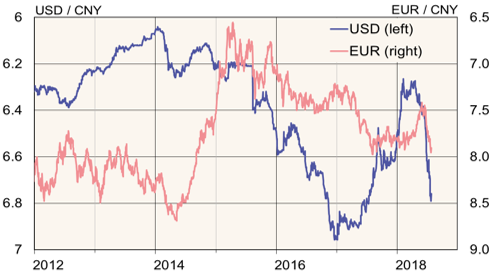BOFIT Weekly Review 30/2018
Yuan depreciation continued in July
The dollar-yuan rate saw last week its largest monthly shift after the ending of the de facto pegging of the yuan to the dollar in 2005. As of today (July 27), the yuan was down 6 % from the start of June. Over the same period, the dollar's trade-weighted exchange rate has remained essentially unchanged. The yuan has lost 6 % also against the euro since the start of June. The yuan's nominal effective exchange rate (NEER) is about where it was at the start of this year.
Chinese exchange rate moves are still relatively modest. This year the yuan's average daily fluctuation against the dollar has been only 0.2 %, compared to e.g. fluctuations of 0.4 % for the yen and euro and 0.6 % for the rouble against the dollar.
The yuan depreciation has also tightened tensions in trade policy talks. US president Donald Trump last week accused the Chinese of artificially devaluing their currency to support exports. China's foreign ministry says the drop is due to market factors, and China does not intend to devalue its currency to stimulate exports.
The exchange rate trend also reflects dollar strength and conditions on China's domestic market. The US Federal Reserve moves to higher interest rates, whereas China's monetary stance is becoming more accommodative to boost growth in the presence of market uncertainties.
Even so, officials seem to be refraining from intervening as they did after the mini-devaluation of the yuan in summer 2015. The State Administration of Foreign Exchange (SAFE) reports that pressure to move capital out of the country today is considerably lower than three years ago. China has a range of measures available if needed to prop up the yuan.
Yuan-dollar and yuan-euro rates

Sources: Reuters and ECB.